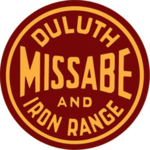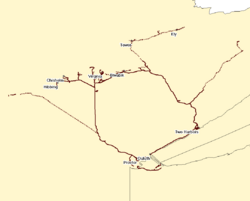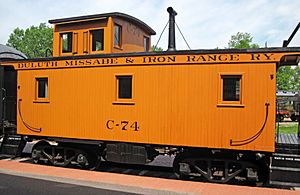Duluth, Missabe and Iron Range Railway facts for kids
 |
|

Map of the DM&IR. Solid lines are track still in use; dotted lines are abandoned track.
|
|
| Overview | |
|---|---|
| Headquarters | Proctor, Minnesota |
| Reporting mark | DMIR |
| Locale | Saint Louis County / Lake County, Minnesota and Douglas County, Wisconsin |
| Dates of operation | 1874–2011 |
| Technical | |
| Track gauge | 4 ft 8 1⁄2 in (1,435 mm) standard gauge |
The Duluth, Missabe and Iron Range Railway (DM&IR), also known as the Missabe Road, was a railroad in northern Minnesota and Wisconsin. It mainly carried iron ore and later taconite to ports on the Great Lakes like Duluth and Two Harbors, Minnesota. In 2004, the Canadian National Railway (CN) bought the company.
Contents
A Railroad's Story
The DM&IR was created in 1937. It was formed by joining two main railroads: the Duluth, Missabe and Northern Railway (DM&N) and the Duluth and Iron Range Rail Road (D&IR). A few smaller railways also joined them.
The D&IR started in 1874. It was built by Charlemagne Tower. Its job was to move iron ore from mines in Tower, Minnesota, to a new port called Two Harbors, Minnesota, on Lake Superior. On July 31, 1884, the D&IR carried its first load of ore from the Soudan Mine. Later, in 1901, the D&IR became part of the United States Steel Corporation (USS).
After a lot of high-quality iron ore was found in the Mesabi Range, the D&IR was asked to build a new line. They said no. So, in 1891, a group called the Merritts started the DM&N. This new railroad shipped its first iron ore to Superior, Wisconsin, in October 1892. The Merritts then built tracks to Duluth, Minnesota, and made an ore dock there. This expansion cost a lot of money. In 1894, John D. Rockefeller took control of the DM&N. In 1901, Rockefeller sold the DM&N to USS.
From 1901 to 1938, USS owned both railroads, but they ran separately. The amount of ore they carried reached its highest point in 1929. They moved about 27.6 million tons that year. But by 1932, it dropped to only 1.5 million tons.
The Big Merger


In July 1938, the two railroads finally merged to form the DM&IR. This new company had two main parts, called the Missabe and the Iron Range. These names came from the original railroads. As the Second World War began, the amount of iron ore moved by the Missabe Road grew very quickly. In 1938, they moved about 8 million tons. By 1941, this jumped to over 37 million tons!
To help with the war effort, the DM&IR got powerful new 2-8-8-4 Yellowstone locomotives in 1941 and 1943. These were very large steam engines. The railroad also used other big steam locomotives. The 2-8-8-4 engines were slowly retired in the late 1950s. The last ones stopped running around 1960.
New Engines and Growth
After World War II, the DM&IR continued to carry more and more ore. In 1953, they moved a record of over 49 million tons. That year, the first diesel locomotives arrived. These new engines used diesel fuel instead of steam. In 1956, the railroad bought more diesel engines. The last time a steam engine was used for regular service was in 1961.
Passenger train service on the Missabe division ended in 1957. All passenger service on the entire railroad stopped in 1961.
| Year | Traffic |
|---|---|
| 1925 | 2115 |
| 1933 | 806 |
| 1944 | 3733 |
| 1960 | 2696 |
| 1970 | 2202 |
As the supply of high-quality iron ore became less, many mines in Minnesota's iron ranges started to close. The DM&IR's ore docks in Two Harbors closed in 1963. They reopened in 1966. The railroad was saved by a new law passed in 1963. This law helped the taconite industry grow in Northern Minnesota. Taconite is a lower-grade iron ore that needs more processing. In 1966, the ship SS Edmund Fitzgerald carried the first load of taconite pellets. This started the "taconite era" for the Missabe Road.
Changing Owners
In 1988, the company that owned DM&IR, USX (formerly U.S. Steel), sold most of its control to another group. Then, in 2001, the DM&IR became part of a new company called Great Lakes Transportation (GLT). For the first time in over 100 years, the DM&IR was not directly linked to U.S. Steel. In late 2003, the Canadian National Railway (CN) agreed to buy GLT. The sale was completed on May 10, 2004.
Joining Wisconsin Central
In December 2011, the Duluth, Missabe & Iron Range Railway officially merged into Wisconsin Central Ltd.. This company is also controlled by the Canadian National Railway. This merger was done to make the railroad operations more efficient.
|


